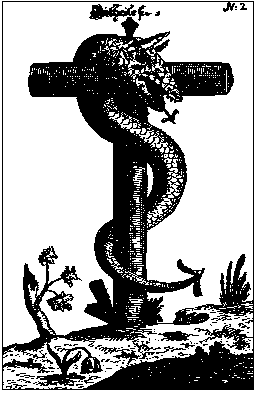
Sator Arepo Tenet Opera Rotas
The central N in "tenet" can stand for Nahas (snake, fish/ichthys). "Setaer ro 's pinnah nahas" then meant: "The secret of the turning point is the snake".
Nahas has the same numerical value as Messiah.
In Gnostic representations we repeatedly see the snake nailed to the "tau", a symbol of the caduceus, the original symbol of magic. The relevant word is the Hebrew TOLa, beginning with a tau and translated as "worm". But this worm is not just any worm, it is the Chermes, a worm with enormous importance for the world of the OT or the Torah at that time.
The name Chermes derives from the Sanskrit word "krimidja" (procreation by a worm, "krim" means worm in Persian) and is still used in many European languages today. The French word "cramoisi", the English "crimson" and the German "Karmin" or "Karmesin" are derived from it.
I can't find an etymological bridge from Chermes to Hermes, but if you know the whole history of this worm, then you could very well imagine such a connection.
This little animal is actually an insect (Coccus ilicis) and it is the ancient provider of the magic color par excellence, namely scarlet red (crimson).
When the female of the scarlet worm gives birth to offspring, she glues her body so firmly and inextricably to an evergreen oak that she will never leave that place again. She has deposited her eggs under her body and now protects them with the shield of her body. When she dies, the scarlet dye permeates her body and the wood that surrounds her. And one of the three most important - and most expensive - dyes of antiquity was extracted from these nodules.
But not only that. Here a being dies on the tree and gives its "blood" (the bright red color is very reminiscent of fresh blood) to "bring many sons to glory" like Jesus Christ (Heb. 2:10). The worm, the serpent, dies "that by him/her we may live" (Ps. 22:6). At least that seems to be the Christian religious view of the analogy.
The Gnostic approach goes deeper, however, and the magical dye was used to dye a specific wool called "Tola'at Shani". The threads of this wool were woven into the curtains of the temples and into the robes of the priests, and it was their magical ingredient. That part that made the transformation possible and one's total devotion to the well-being of the offspring.
An important ancient ritual shows this aspect quite vividly: Two birds were put in a box and one bird was killed with a dagger. Its blood spilled over the "Tola'at Shani", soaking it and wetting the second bird, which was then released alive. This is a true phoenix ritual and demonstrates the magical power of the transformative power that arose from the Chermes worm analogy.
As I said "Tola" means worm. The word "Shani" goes back to the ancient root of the word "Shana". It means "change" and "change".
The sentence: "The secret of the turning point is the snake" becomes a lot more understandable if one reads "snake" as "worm of change" in the presented context. "Shin", as a seraphim of fire, goes very well with the crimson of the dye and the death on the cross becomes understandable as self-sacrifice for one's own children.
The connections are very diverse and it seems worthwhile to deal more intensively with this analogy. Because the "worm" is also a common term for a child and - with a certain contempt - for the penis.
